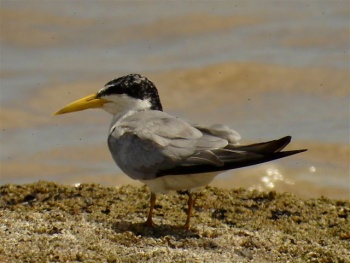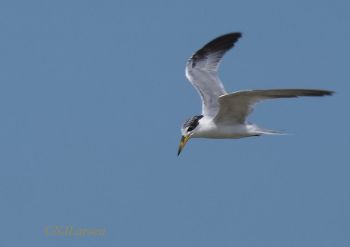- Sternula superciliaris
Sterna superciliaris
Identification
23 cm (9 in)
- Yellow bill
- Yellow legs
- Black cap
- White forehead
- In flight it shows dark outer primaries both above and below and a very shallow fork in the short tail
Juvenile browner than adult, with more orange bill and dark both on tip and on a saddle at the base of the culmen.
Later during first year, the plumage is more like adult, but having dark rear to the eye but pale grey crown. A dark carpal bar is seen on upperwing and can be seen in the standing bird. Dark saddle and tip on the bill continues a period after the bill turns yellow in base color and then gradually disappears.
Similar Species
In comparison to Least Tern, the bill averages bigger and yellower, lacking black tip. Also Yellow-billed Tern has longer legs and more black in its wings.
Distribution
Central and South America
Central America: Trinidad, Tobago
South America: Colombia, Venezuela, Guyana, Suriname, French Guiana, Ecuador, Peru, Bolivia, Brazil, Paraguay, Uruguay, Argentina
Taxonomy
This is a monotypic species[1].
Yellow-billed Tern is closely related to Least Tern and Little Tern S. albifrons of the Old World. Other close relatives include the Peruvian Tern S. lorata of South America. Like all of these, it was formerly placed in the genus Sterna.
Habitat
Rivers, swamps, and freshwater lakes. Coastal in the Guianas where moulting in large numbers.
Behaviour
Frequently hovers when hunting.
Diet
Their diet consists of small fish, shrimps and insects.
References
- Clements, J. F., T. S. Schulenberg, M. J. Iliff, D. Roberson, T. A. Fredericks, B. L. Sullivan, and C. L. Wood. 2018. The eBird/Clements checklist of birds of the world: v2018. Downloaded from http://www.birds.cornell.edu/clementschecklist/download/
- Avibase
- Arthur Grosset
- Gochfeld, M., Burger, J., Garcia, E.F.J. & Boesman, P. (2019). Yellow-billed Tern (Sternula superciliaris). In: del Hoyo, J., Elliott, A., Sargatal, J., Christie, D.A. & de Juana, E. (eds.). Handbook of the Birds of the World Alive. Lynx Edicions, Barcelona. (retrieved from https://www.hbw.com/node/54034 on 30 June 2019).
- Yellow-billed Tern (Sternula superciliaris), In Neotropical Birds Online (T. S. Schulenberg, Editor). Cornell Lab of Ornithology, Ithaca, NY, USA. retrieved from Neotropical Birds Online: https://neotropical.birds.cornell.edu/Species-Account/nb/species/yebter2
- birdforum member observations.
Recommended Citation
- BirdForum Opus contributors. (2024) Yellow-billed Tern. In: BirdForum, the forum for wild birds and birding. Retrieved 27 July 2024 from https://www.birdforum.net/opus/Yellow-billed_Tern
External Links
GSearch checked for 2020 platform.1







